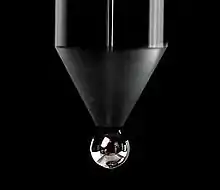Dropping mercury electrode
The dropping mercury electrode (DME) is a working electrode made of mercury and used in polarography. Experiments run with mercury electrodes are referred to as forms of polarography even if the experiments are identical or very similar to a corresponding voltammetry experiment which uses solid working electrodes. Like other working electrodes these electrodes are used in electrochemical studies using three electrode systems when investigating reaction mechanisms related to redox chemistry among other chemical phenomena.[1][2][3][4][5]

Structure
A flow of mercury passes through an insulating capillary producing a droplet which grows from the end of the capillary in a reproducible way. Each droplet grows until it reaches a diameter of about a millimeter and releases. The released droplet is no longer in contact with the working electrode whose contact is above the capillary. As the electrode is used mercury collects in the bottom of the cell. In some cell designs this mercury pool is connected to a lead and used as the cell's auxiliary electrode. Each released drop is immediately followed by the formation of another drop. The drops are generally produced at a rate of about 0.2 Hz.
Considerations
A major advantage of the DME is that each drop has a smooth and uncontaminated surface free from any adsorbed analyte or impurity. The self-renewing electrode does not need to be cleaned or polished like a solid electrode. This advantage comes at the cost of a working electrode with a constantly changing surface area. Since the drops are produced predictably the changing surface area can be accounted for or even used advantageously. In addition the drops' growth causes capacitive current and faradaic current. These changing current effects combined with experiments where the potential is continuously changed can result in noisy traces. In some experiments the traces are continually sampled, showing all the current deviation resulting from the drop growth. Other sampling methods smooth the data by sampling the current at the electrode only once per drop at a specific size. The DME's periodic expansion into the solution and hemispherical shape also affects the way the analyte diffuses to the electrode surface. The DME consists of a fine capillary with a bore size of 20–50 µm.
References
- Bard, Allen J.; Larry R. Faulkner (2000-12-18). Electrochemical Methods: Fundamentals and Applications (2 ed.). Wiley. ISBN 978-0-471-04372-0.
- Zoski, Cynthia G. (2007-02-07). Handbook of Electrochemistry. Elsevier Science. ISBN 978-0-444-51958-0.
- Kissinger, Peter; William R. Heineman (1996-01-23). Laboratory Techniques in Electroanalytical Chemistry, Second Edition, Revised and Expanded (2 ed.). CRC. ISBN 978-0-8247-9445-3.
- Skoog, Douglas A.; F. James Holler; Timothy A. Nieman (1997-09-03). Principles of Instrumental Analysis (5 ed.). Brooks Cole. ISBN 978-0-03-002078-0.
- Baars, A.; M. Sluyters-Rehbach; J. H. Sluyters (January 1994). "Application of the dropping mercury microelectrode (DMμE) in electrode kinetics and electroanalysis". Journal of Electroanalytical Chemistry. 364 (1–2): 189–197. doi:10.1016/0022-0728(93)02918-8.